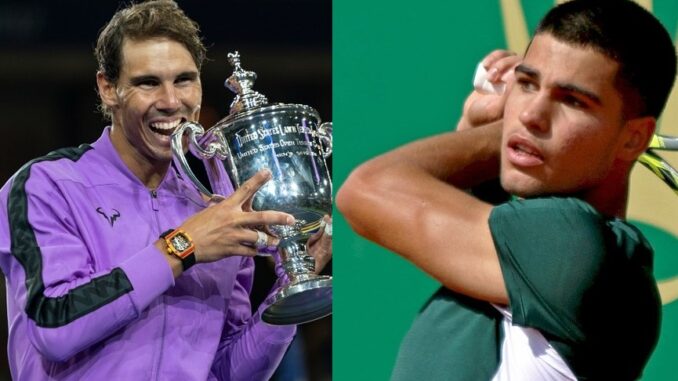
On September 11, 2022, roughly four months after turning 19 years old, Carlos Alcaraz won his first Grand Slam title in Flushing Meadows, defeating Casper Ruud in the final, and thus becoming the new ATP number 1.
Not only his stunning early career and his nationality, but also his unbreakable temperament, often lead to a comparison between Carlos Alcaraz and Rafael Nadal.
In this article, we will try to analyze this comparison having a closer look at the statistics of the matches played by the two champions. More precisely: with the final match at US Open, Alcaraz played his 111th match at ATP level.
Being aware that, due to the different circumstances, any comparison among players, especially if they belong to two different generations, is imperfect, let us try, however, to have a closer look at what Nadal did, in his first 111th ATP matches.
Firstly, let’s compare the careers of the two players, after 111 matches: Nadal had won the Davis Cup in 2004 and reached two Master 1000 finals, both in 2005, losing from Federer in Miami and winning his first Master 1000 title in Monte Carlo, defeating Guillermo Coria in four sets (6-3, 6-1, 0-6, 7-5): that final was, actually, his 111th match.
Shortly after, he will win his first Grand Slam title, in Paris.
We must acknowledge that, after the same number of matches, Alcaraz has achieved even more. He has already won two Master 1000 titles (Miami and Madrid, in 2022) and, very recently, his first Grand Slam title (US Open 2022).
But this first level of comparison is, of course, not enough. Let’s have a closer look at the statistics of the first matches by Nadal and by Alcaraz, trying to understand the key elements of their play, and how well they work, starting to analyze how the two Spanish champions handle their games on serve.
Also Read:
- Remembering the Rafael Nadal Loss to Robin Soderling
- When Roger Federer Played Novak Djokovic for the First Time
Serve Games
In Figure 1 we see, on the horizontal axis, the number of matches played while, on the vertical axis, we have the average percentage of points won on first serve by Nadal (in blue) and Alcaraz (in orange) in those matches.
For example, if we have a look above the “31” label on the horizontal axis, we will see what the average percentage of points won on first serve was for Nadal and Alcaraz, after their first 31 matches.
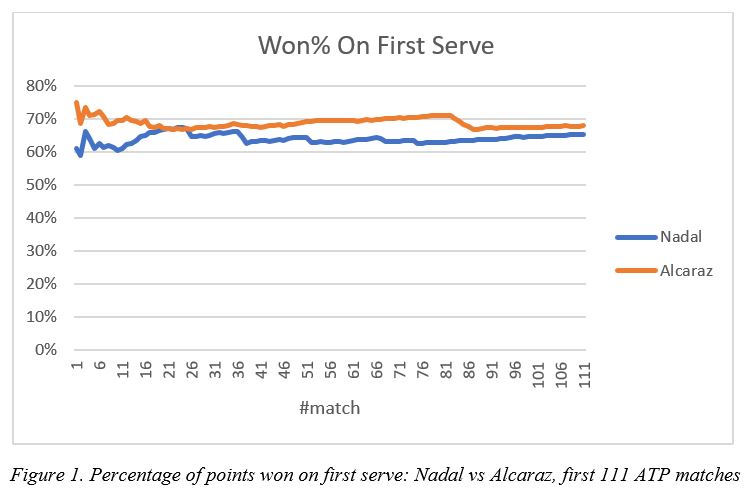
Figure 2 below shows a similar plot, but it addresses the percentage of points won on second serve.
The initial part of the plots (on the left) is too fragile to be trusted, because it relies on a very limited number of matches, while the plot gets more and more reliable towards the final part (on the right).
We can notice that Alcaraz looks slightly superior to Nadal (in his early career) when his first serve is in.
In fact, this does not surprise us, not only because of the power and versatility of Alcaraz’s serve, but also because Nadal’s serve, especially at the beginning of his career, was far from being his best shot.
It is also because of that that Rafa achieved his first Major title on a surface different from clay only in 2008, winning a legendary Wimbledon final against Federer.
It is maybe more surprising to observe that Alcaraz looks slightly superior, according to the statistics, also for what concerns the percentage of points won on second serve.
Yet, there is another observation to be considered: in both plots, Nadal’s scores are slowly but steadily increasing. This, once more, reminds us that he is not only a gifted player, but a great worker, improving his skills game after game.
If we look at the very final part of the plot, Alcaraz looks on an increasing trend too, but the picture is not equally clear, from this point of view. Before trying to sum up what the number might suggest, let’s have a look also at what happens in return games.
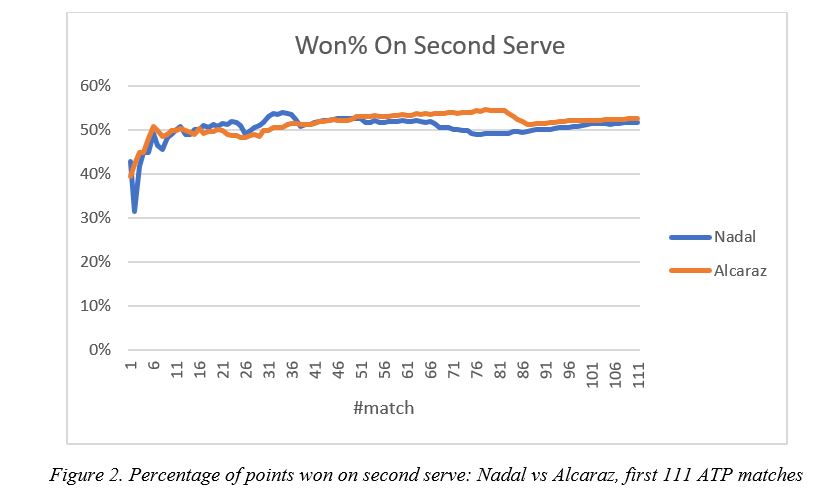
Also Read:
Return Games
In Figure 3 we see, on the horizontal axis, the number of matches played while, on the vertical axis, we have the average number of break points in favor of Nadal (in blue) and Alcaraz (in orange) in those matches.
For example, if we have a look above the “25” label on the horizontal axis, we will see what the average number of break points in favor of Nadal or Alcaraz, after their first 25 matches.
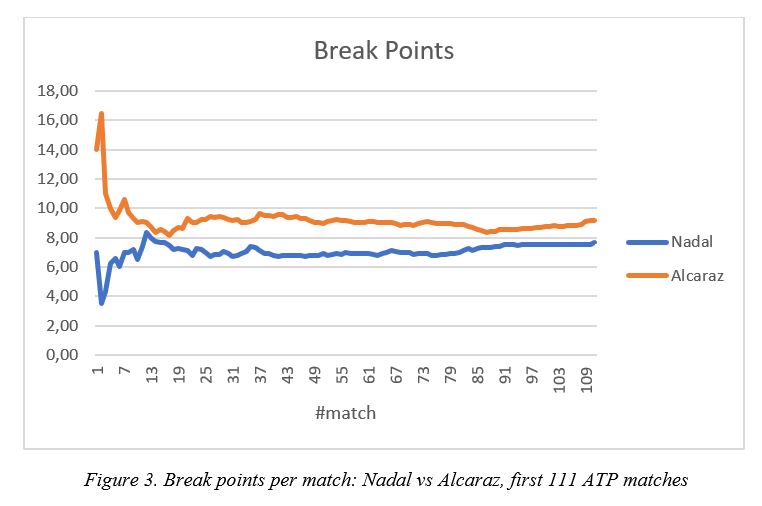
Figure 4 shows a similar plot, but it addresses break point effectiveness. Again, the initial part of the plots (on the left) is too fragile to be trusted, because it relies on a very limited number of matches, while the plot gets more and more reliable towards the final part (on the right).
In terms of the absolute number of break points, Alcaraz looks slightly superior with respect to early Nadal. This is likely to have something to do with the greater variety of shots by Alcaraz, that offer him the chance to surprise its opponent, even in return games.
Yet, the more interesting statistics is probably break point effectiveness.
As we can see, not only Nadal is, in this case, superior to Alcaraz, but also the two trends seem to be diverging: Nadal moves along his (usual), slowly increasing pattern, while Alcaraz’s statistics exhibits a flat, if not slowly decreasing behavior.
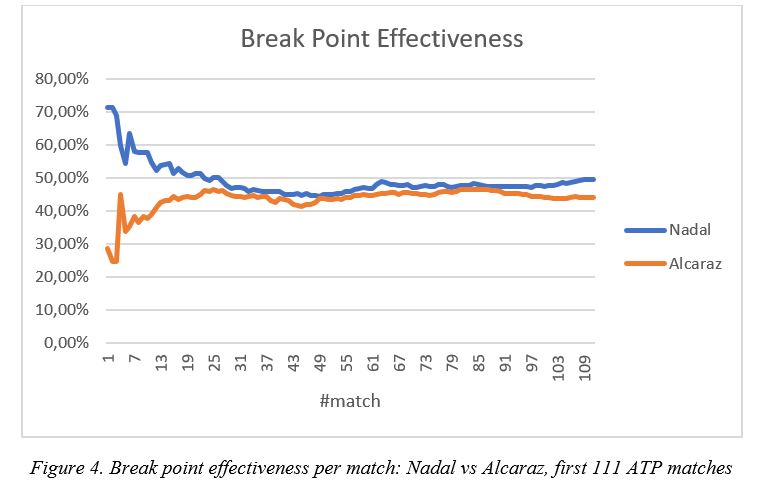
Of course, we cannot restrict the style of play of two champions to a small set of numbers and statistics: still, this final plot, combined with the others, could give us a hint to sum up our little analysis.
Alcaraz is for sure one of the most talented and determined players of his generation, up to the point of outscoring Nadal, in statistical terms, from different points of view, especially on serve.
Yet, if he wishes to continue on his winning path, he may need to further improve his “killer instinct”, that is the ability to enhance his level of play during crucial points: a skill that, as we all remember, even beyond what numbers show, Rafa demonstrated since his very first day on the circuit, and keeps on demonstrating now.